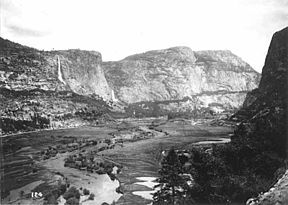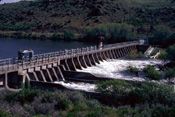California Energy Crash Coming
by CalWatchdog Staff | February 8, 2012 8:01 am
FEB. 8, 2012
By KATY GRIMES
Ready for more electricity blackouts?
With California’s renewable energy mandates, cap and trade requirements[1], and implementation of AB 32[2], it is becoming increasingly clear that California is at a precarious energy crossroads, and one that lawmakers don’t yet appear willing to address. [3]
[3]
They are still busy patting themselves on the back for passage of the Renewable Portfolio Standard[4]. But lawmakers will soon be forced to address the upcoming lawmaker-made energy crisis because their renewable energy mandates won’t be able to power the state.
An new study [5]released by the California Independent System Operator,[6] CalISO, warns that as California tries to meet the stringent requirements of the Renewable Portfolio Standard of 33 percent renewable energy production, “so does the need for flexible capacity resources.”
“Integrating a 33 percent Renewable Portfolio Standard[4] creates several new challenges for the ISO,” the study states[7]. “Among these challenges is ensuring that the ISO has sufficient flexible capacity to address the added variability and unpredictability created by intermittent resources.”
The 33 percent figure is no coincidence, as the Legislature pushed through and passed the environmentally restrictive Renewable Portfolio Standard[8], which mandates that California obtain 33 percent of all electricity from renewable resources by 2020.
CalISO[9] is a quasi-governmental agency, which exists to regulate the reliability of the state electrical grid. It appears that CalISO doesn’t believe that meeting the RPS of 33 percent renewable energy is possible, even though “CalISO also is partnering with California’s energy and environmental agencies to implement a new vision for California’s Clean Energy Future….
“California is making plans to link the cap-and-trade system with that of Quebec in 2012, under the auspices of the Western Climate Initiative, but challenges remain as allowances trade at record lows.” So far, no other countries are interested in participating in trading carbon credits.
What’s In Store
Before anyone gets too excited about our relationship with Quebec, California is not trading apples-to-apples: Quebec gets 97 percent of its energy from hydroelectric sources. While California is trying to reduce traditional electricity production, including hydro, and instead replace it with as much “renewable” energy as possible from wind and solar, algae, and ethanol, energy experts have been saying for months that California’s energy demand is too much for the alternative energy.
“This will create the largest carbon market in North America and provide a model that can guide future efforts to establish a creative road map for future national approaches in Canada and the US to reduce greenhouse gas [GHG] emissions,” said WCI[10] co-chairmen James Goldstene, executive officer of the California Air Resources Board[11], and Jim Whitestone of Ontario’s Ministry of the Environment.
But Cal EPA and CARB officials all seem to have a “If you build it, they will come” attitude.
Hetch Hetchy or Klamath Dam
Under fire at this very moment is the Klamath Dam[12], which provides hydroelectric power and serves 70,000 mostly rural households, annually. In many cases, the dam removal is simply to save fish, and kayaking waters. “While the dam removal would result in the loss of hydroelectric power generation, which will have to be made up from other sources, and the loss of around 50 jobs from managing those facilities, it would also create a substantial number of jobs — varying in nature, duration, and location — estimated at approximately 1,400 during the short-term,” stated Interior Secretary Ken Salazar. [13]
[13]
But a May 2006 U.S. Supreme Court ruling sided with fish and kayakers over hydroelectric plants, stating, “state regulators may require a steady flow of water over power dams,” according to the Los Angeles Times[14].
Contrast the Klamath Dam[12] with the revered Hetch Hetchy dam, which provides water for San Francisco. In 1906, after the big San Francisco earthquake, San Francisco applied to the United States Department of the Interior to gain water rights to Hetch Hetchy. It’s been the darling dam of the state ever since, and the only one environmentalists will tolerate.
Salazar is going to make a decision on demolition of the Klamath Dam in March. But the reasons appear to be purely political and supportive of the environmentalist agenda. A recent story arguing for the demolition of the dam[15] could be flipped on its head. “A draft report released Tuesday by the U.S. Interior Department says removing four hydroelectric dams in the Klamath Basin will restore salmon and sustain irrigation for farmers in Southern Oregon and Northern California,” the story[16] stated.
Replace “Hetch Hetchy” with “Klamath” in this story[17] — think of all the “jobs” we could create or save by tearing down Hetch Hetchy’s O’Shaughnessy Dam.
Ironically, the Renewable Portfolio Standard[4] pushers have steadfastly refused to acknowledge that hydroelectric power substantially contributes to the 33 percent renewable goal, as it does in Quebec. Unlike solar and wind power, hydroelectric power is affordable, renewable and abundant.
In June, the Legislature killed part of a bill that would have added all hydroelectric power to the California Renewables Portfolio Standard. Sen. Bob Dutton, R-Rancho Cucamonga, authored SB 1247[18], a bill that would have added large hydroelectric power to the list of California’s eligible renewable energy resources, and broaden the definition of “eligible renewable energy resources.”
This proved that the RPS[19] was just another mandate supporting the unreliable solar and wind agenda.
However, while California has rejected hydroelectric power as a renewable energy source, the U. S. Environmental Protection Agency still considers hydropower “a renewable energy resource because it uses the Earth’s water cycle to generate electricity.”
High-Speed Energy Crash
As the 33 percent renewable portfolio gets underway, AB 32 implementation [20]begins, the conveyance issues over water increase and state officials continue to steam ahead with High-Speed Rail, it appears that California is headed for an energy crash.
High-Speed Rail plans show that the system will be a massive drain on the state’s electricity grid, and solar and wind are not going to be able to fulfill the draw.
A Berkeley study [21]found, “under current conditions—with the model of HSR trains proposed and its energy source, as well as the types of automobiles and airplanes now in existence, that high-speed rail has the potential to be the lowest energy consumer and greenhouse gas emitter only if it consistently travels at high occupancy or uses a low-emission electricity source such as wind, both of which will require appropriate planning and continued investment.”
But High-Speed Rail ridership already looks bleak[22], according to another U.C. Berkeley study, which found ridership numbers “not reliable.”
Others say that the system is going to take massive amounts of electricity, raising questions about the power grid’s ability to meet the demand. The environmental-impact reports for the High-Speed Rail system could use more than 3 billion kilowatt-hours (kWh) a year by the time it’s fully operational statewide.
The average California home uses about 6,960 kilowatt-hours in a year. At that rate, it would take more than 430,000 households to use what the train system would consume, the Fresno Bee reported[23].
California Conundrum
The Klamath Dam provides hydroelectric power to an entire region of the state, as well as 70,000 households. The High-Speed Rail will drain enough electricity from an already tapped electricity grid, equal to 430,000 households. Where will the additional power come from? Solar rooftops? Wind farms? Where will the electric cars plug in? [24]
[24]
Solar, wind, algae, ethanol and other renewable energy sources are intermittent, unreliable, and not always environmentally-friendly. Wind farm construction is on hold because of an endangered tortoise.[25] The environmentalists are now fighting each other.
It is becoming increasingly apparent that California cannot keep up with the renewable energy mandates.
- cap and trade requirements: http://arb.ca.gov/cc/capandtrade/capandtrade.htm
- AB 32: http://www.arb.ca.gov/cc/cc.htm
- [Image]: http://www.calwatchdog.com/wp-content/uploads/2012/02/288px-Hetch_Hetchy_Valley.jpg
- Renewable Portfolio Standard: http://www.cpuc.ca.gov/PUC/energy/Renewables/index.htm
- new study : http://www.caiso.com/Documents/IssuePaper-FlexibleCapacityProcurement.pdf
- California Independent System Operator,: http://www.caiso.com/about/Pages/OurCommitment/default.aspx
- study states: http://www.caiso.com/Documents/IssuePaper-FlexibleCapacityProcurement.pdf
- Renewable Portfolio Standard: http://www.calwatchdog.com/2011/03/29/logue-sees-red-over-green-bill/
- CalISO: http://www.caiso.com/about/Pages/OurCommitment/default.aspx
- WCI: http://en.wikipedia.org/wiki/Western_Climate_Initiative
- California Air Resources Board: http://en.wikipedia.org/wiki/California_Air_Resources_Board
- Klamath Dam: http://www.klamathwaterquality.com/project.html
- [Image]: http://www.calwatchdog.com/wp-content/uploads/2012/02/link_river_dam_small.jpg
- according to the Los Angeles Times: http://articles.latimes.com/2006/may/16/nation/na-enviro16
- story arguing for the demolition of the dam: http://www.sfgate.com/cgi-bin/article.cgi?f=/n/a/2012/01/24/state/n165301S81.DTL#ixzz1liLsd7CJ
- story: http://www.sfgate.com/cgi-bin/article.cgi?f=/n/a/2012/01/24/state/n165301S81.DTL#ixzz1liLsd7CJ
- this story: http://www.sfgate.com/cgi-bin/article.cgi?f=/c/a/2012/01/30/ED6C1MVIVB.DTL&type=printable
- SB 1247: http://info.sen.ca.gov/pub/09-10/bill/sen/sb_1201-1250/sb_1247_bill_20100322_amended_sen_v98.html
- RPS: http://www.cpuc.ca.gov/PUC/energy/Renewables/index.htm
- AB 32 implementation : http://www.arb.ca.gov/cc/cc.htm
- Berkeley study : http://its.berkeley.edu/btl/2010/spring/HRS-life-cycle
- High-Speed Rail ridership already looks bleak: http://www.its.berkeley.edu/publications/UCB/2010/RR/UCB-ITS-RR-2010-1.pdf
- reported: http://www.fresnobee.com/2011/09/25/2553219/high-speed-rail-would-test-power.html#storylink=cpy
- [Image]: http://www.calwatchdog.com/wp-content/uploads/2012/02/desert-tortoise.jpg
- endangered tortoise.: http://www.treehugger.com/solar-technology/threatened-tortoises-slow-down-desert-solar-project.html
Source URL: https://calwatchdog.com/2012/02/08/california-energy-crash-coming/